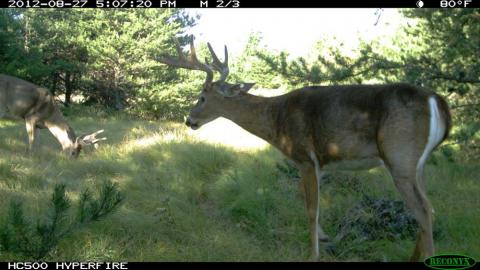HOW TO USE TRAIL CAMERAS TO CONDUCT A FAIRLY RELIABLE POPULATION INDEX OF YOUR DEER HERD.
Bob Humphrey
Trail cameras have been a boon for deer hunters. They are your eyes in the woods when you are not there. They allow you to scout while minimizing your presence, disturbance and intrusion. And they’re a lot of fun. Plugging that SD card into your computer or reading a message on your smart phone is like opening presents on Christmas morning, with all the excitement and anticipation of wondering if there’s something special inside that package.
From a purely hunting perspective, trail cameras are a great tool, but they can also be quite useful if your interest goes beyond merely harvesting bucks. In addition to making your scouting much more efficient, trail cameras can also be a valuable wildlife management tool. Mississippi State University researchers Dr. Stephen Demarais, William McKinley and Dr. Harry Jacobson developed and refined an infrared-triggered camera survey technique that can provide an accurate survey of your local deer population with a surprisingly small investment in time and equipment. Here’s how it works…
EQUIPMENT

Obviously, you’ll need a piece of property, and cameras. The former will be your biggest expense, but presumably you’ve already made that investment. For cameras, you don’t need to break the bank. Any basic trail camera that will record an image with a time stamp will work. How many you need depends on the size of your property and how accurate you want your results to be. As a general guideline, one camera per 100 acres should suffice.
While not necessary, feeding stations will produce a better result. Establish them at the same one per 100-acre ratio. They can be a full-blown supplemental feed station, or something as simple as a pile of mineral supplements or attractants.
SETUP
Begin by dividing your property into approximately 100-acre blocks. Next, place one camera in each block. Adding more won’t hurt, but isn’t necessary. They need not be evenly spaced. Unlike researchers who try to avoid bias you want to encourage it by placing cameras in areas heavily utilized by deer, like two-tracks, skid roads, the edges of food plots or agricultural fields, heavily traveled deer trails or the aforementioned feed stations. In the latter case it is advised to pre-bait for at least 5 days prior to survey.
Make sure your cameras are working properly and loaded with fully charged batteries. Set all of cameras to record date and time of each photo, and on a 10-minute delay to avoid an unnecessary glut of images. Face camera north or south to avoid backlighting, and clear all vegetation from the detection zone to prevent false events.
IMPLEMENTATION
For optimum results, conduct two surveys, one just before hunting season and another just after. You can vary as necessary but come as close to those guidelines as possible.
Run your survey for a minimum of 5 to 10 days. You will achieve greater accuracy with a longer, 10- to 14-day survey, which should ensure you are photographing close to 90 percent of both bucks and does.
ANALYSIS

Analysis is surprisingly simple and straightforward. After the survey is complete, compile all of your photographs and count the number of bucks, does and fawns photographed as follows:
Bucks
- the total number of bucks in the photos, including repeats
- the actual of number of individual (unique) bucks.
Step 2 is most easily done using antler characteristics such as number of points, abnormal points, tine length, spread or other distinguishable antler or body characteristics. Exclude any deer that are unidentifiable from the survey. The result is your buck population.
Does
- the total number of does and fawns in the photos, including known repeats.
To estimate the number of does and fawns, take the number of unique bucks (#2 above) and divide this by the total number of bucks photographed (#1 above). Then multiply the resulting population factor (#2 divided by #1) by the number of does and fawns counted in the photos.
From this information, you can also calculate a buck:doe ratio and a fawn:doe ratio. If you are skilled enough, you can even take a stab at aging the bucks, then sort them by age class to determine age structure. Repeating the survey over multiple seasons allows you to observe trends, which are often far more valuable than an actual population estimate for any given year.
CONCLUSION
Above are just some of the ways you can incorporate trail cameras into your hunting and management plans. As technology continues to advance and hunters seek new and different ways to outwit their quarry, more uses will no doubt be discovered. That’s all part of the process, which is really the most important part of any hunt.
(Acknowledgments: Jason R. Snavely, Drop-Tine Wildlife Consulting, Millville, PA; The Quality Deer Management Association; Dr. Stephen Demarais and Dr. Harry Jacobson, Mississippi State University; William McKinley, Mississippi Department of Wildlife, Fisheries and Parks.)



